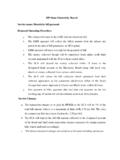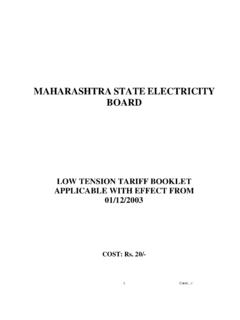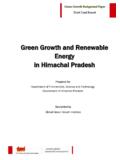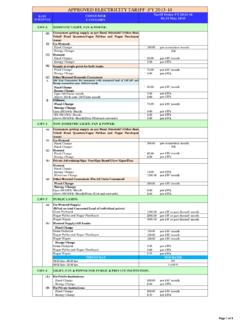Transcription of SOLAR PV SYSTEM DESIGN - Top private| NIT| …
1 SOLAR PV SYSTEM DESIGN A SOLAR PV SYSTEM DESIGN can be done in four steps: Load estimation Estimation of number of PV panels Estimation of battery bank Cost estimation of the SYSTEM . Base condition:2 CFLs(18 watts each),2 fans (60 watts each) for 6hrs a day. The total energy requirement of the SYSTEM (total load) Total connected load to PV panel SYSTEM = No. of units rating of equipment = 2 18 + 2 60 = 156 watts Total watt-hours rating of the SYSTEM = Total connected load (watts) Operating hours = 156 6 = 936 watt-hours Actual power output of a PV panel = Peak power rating operating factor = 40 = 30 watt The power used at the end use is less (due to lower combined efficiency of the SYSTEM = Actual power output of a panel combined efficiency = 30 = watts (VA) = watts Energy produced by one 40 Wp panel in a day = Actual power output 8 hours/day (peak equivalent))
2 = 8 = watts-hour Number of SOLAR panels required to satisfy given estimated daily load : = (Total watt-hour rating (daily load)/(Daily energy produced by a panel) =936 = = 5 (round figure) Inverter size is to be calculated as : Total connected load to PV panel SYSTEM = 156 watts Inverter are available with rating of 100, 200, 500 VA, etc. Therefore, the choice of the inverter should be 200 VA. COST ESTIMATION OF A PV SYSTEM (a) Cost of arrays = No. of PV modules Cost/Module = 5 8000 (for a 40 Wp panel @ ) = (b) Cost of batteries = No. of Batteries Cost/Module =1 7500= (c) Cost of Inverter = No.)
3 Of inverters Cost/Inverter = 1 5000 = 1 5000 = Total cost of SYSTEM = A + B + C = 40000 + 7500 + 5000 = [Additional cost of wiring may be taken as 5% of total SYSTEM cost] ASSUMPTIONS TAKEN FOR DESIGN : Inverter converts DC into AC power with efficiency of about 90%. Battery voltage used for operation = 12 volts The combined efficiency of inverter and battery will be calculated as : combined efficiency = inverter efficiency battery efficiency = = = 81% Sunlight available in a day = 8 hours/day (equivalent of peak radiation. Operation of lights and fan = 6 hours/day of PV panels.)
4 PV panel power rating = 40 Wp (Wp, meaning, watt (peak), gives only peak power output of a PV panel) A factor called operating factor is used to estimate the actual output from a PV module. [The operating factor between and (implying the output power is 60 to 80% lower than rated output power) in normal operating conditions, depending on temperature, dust on module, etc.] DESIGN OF BIOGAS PLANT Biogas SYSTEM DESIGN for cooking for a family of six members is considered here. The SYSTEM DESIGN includes the estimation of total gas required, amount of feedstock (or dung), required and the number of animals required to have feedstock of a given amount.
5 Following assumptions are made for the DESIGN : About 350-450 litres of biogas required per day per person for cooking (in engine about 450 litres/hp/hour of biogas is required) Average production of dung per animal per day: Cow 10 kg/day Bullock 14 kg/day Buffalo 15 kg/day Other biomass night soil, sugar cane bagasse, maize straw, etc. can also be used) 1000 litres of gas is equivalent to 1 m3 of gas. Average gas production from dung is about 40 litres/kg of fresh dung. Retention period of dung slurry in digester is 50 days. AMOUNT OF GAS REQUIRED PER DAY I. Number of family members =6 (adult).
6 Considering 400 litre/day/person for cooking, total gas required = 6 400 = 2400 litres/day or about m3 gas/day. II. Number of animals required to fulfil daily gas requirement = Amount of gas produced from a kg of fresh dung = 40 litre/kg. III. Total amount of dung required = Total gas required/Gas per kg of dung = 2400/40 = 60 kg. IV. Thus, in order to have 60 kg of dung no. of cows required = in order to have 60 kg of dung no. of cows required = 60/10 = 6 cows. DESIGN OF DIGESTER AND GAS HOLDER In order to make slurry, water should be added to equal amount of dung.
7 Total mass of slurry Dung+ Water = 60+60 = 120 kg. Volume of slurry per day (specific gravity of slurry is about 1090 kg/m3) = Total mass of slurry/Specific gravity = 120/1090 = m3 Retention period of slurry = 50 days. Total volume of the digester = per day volume of slurry retention period = 50 = m3 ~ 6 m3. Dimensions of the digester : Depth to diameter ratio should be between 1 and Gas holder tank dimension : The volume of the gas holder tank should be about 60% of the per day gas volume. Various possible costs incurred in manufacturing of a biogas plant is given below: Component Capital cost (Rs.)
8 1. Gas holder and frame 5500 2. Piping and stove 1750 3 .Civil engineering construction 12000 Total cost of biogas plant 19250 SAVING DUE TO USE OF BIOGAS PLANT Assuming that biogas is replacing the use of LPG in a household, following calculations can be done to calculate the amount savings. The amount of LPG required is about 2kg/per person/month Total LPG required for 6 people for a month is 6 2=12 kg/month Cost of LPG per kg is about Rs.
9 24. Total cost of LPG (if used in place of biogas) = 12 24 = per month (this amount is monthly saving.) Total yearly savings = 288 12 = per year Therefore, the simple payback period is = Total cost of biogas plant/yearly savings = 19250/3456 = years ESTIMATION OF REQUIRED WIND TURBINE POWER RATING Assume that annual energy requirement of an industry is 20000 kWh ,we calculate that what will be the size of wind turbine that is required to be installed to meet the energy requirement. Following assumptions are taken into account for estimation: Annual energy requirement 20000 kWh Propeller type wind machine is used Coefficient of performance Wind speed at 15 metre height is 5 metre/sec (if the turbine hub is placed at the height other than 15 metre, the wind speed should be estimated as shown in vertical wind speed variation section.)
10 Density of air 1 kg/m3 Capacity factor ( 30% of the time, wind machine is producing energy at rated power) Number of hours in a year 8760 hours. The power density of wind (power per unit area) = air density (velocity)2 = 1 (5 5 5) = watt/m. Actual power density that will be converted to useful energy = Cp transmission loss generator loss Considering losses Coefficient of performance Cp = Transmission losses (rotor to generator) = Generator losses = Overall loss factor = = Actual power density = = W/m2 Annual energy density (useful) = power density number of hours per year = 8760 = kWh/m2 The rotor size and turbine power rating estimation: Total annual energy required 20000 = -------------------------------------- = ------------- = m2.








